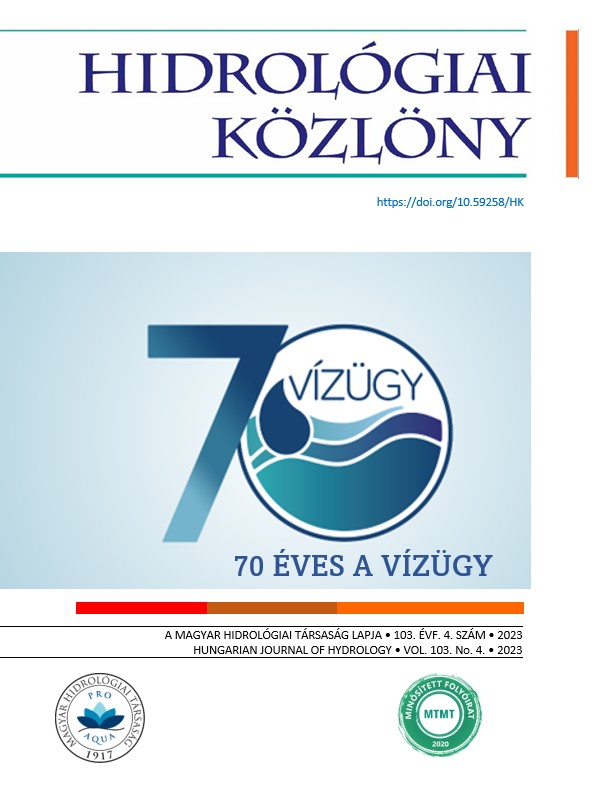Applicability of a velocity-based approach for time of concentration estimation in Hungarian catchments
Abstract
The estimation of time of concentration is required for several hydrologic calculations, such as the application of the rational method or rainfall-runoff modeling. Direct measurement of its value is not possible. Therefore, indirect estimation procedures need to be applied. In a previous research, I estimated time of concentration using observed rainfall and runoff time series for several Hungarian catchments. These values provide a sound basis for comparative studies. It would be of great value if a physically-based method, relying solely on hydraulic parameters, would be proven applicable for time of concentration estimation in ungauged basins. I applied an existing velocity-based approach for six Hungarian catchments and compared the result with the values derived in previous studies using rainfall-runoff data. The presented method could not produce similar values to the latter. Therefore, it is not applicable to estimate time of concentration in ungauged catchments. The reasons behind the presented method’s dysfunctionality are also discussed.
References
Azizian, A. (2018). Uncertainty Analysis of Time of Concentration Equations based on First-Order-Analysis (FOA) Method. American Journal of Engineering and Applied Sciences, 11(1). pp. 327-341. https://doi.org/10.3844/ajeassp.2018.327.341
Beven, K.J. (2020). A history of the concept of time of concentration. Hydrology and Earth System Sciences, 24. pp. 2655-2670.
Corine Land Cover: https://land.copernicus.eu/pan-european/corine-land-cover/clc2018?tab=download
EU-DEM: https://land.copernicus.eu/imagery-%20in-situ/eu-dem/eu-dem-v1.1
Gaál, L., Szolgay, J., Kohnová, S., Parajka, J., Merz, R., Viglione, A., Blöschl, G. (2012). Flood timescales: Understanding the interplay of climate and catchment processes through comparative hydrology. Water Resources Research, 48(4). https://doi.org/10.1029/2011WR011509
Grimaldi, S., Petroselli, A., Tauro, F., Porfiri, M. (2012). Time of concentration: a paradox in modern hydrology. Hydrological Sciences Journal, 57(2). pp. 217-228.
Grimaldi, S., Petroselli, A. (2015). Do we still need the Rational Formula? An alternative empirical procedure for peak discharge estimation in small and ungauged basins. Hydroligal Sciences Journal, 60. pp. 67-77. https://doi.org/10.1080/02626667.2014.880546
Haan, C.T., Barfield, B.J., Hayes, J.C. (1994). Design hydrology and sedimentology for small catchments. London: Academic Press.
Kontur I., Koris K., Winter J. (2003). Hidrológiai Számítások. 3. kiadás, Linográf Kft., Gödöllő.
Koris K. (2021). Magyarország kisvízfolyásainak árvizei. Országos Vízügyi Főigazgatóság, Budapest.
Környezetvédelmi és Vízgazdálkodási Minisztérium (1988). Belterületi vízrendezés, csapadékvízelvezető hálózat, MI-10-455/2-1988.
Michailidi, E.M., Antoniadi, S., Koukouvinos, A., Bacchi, B., Efstratiadis, A. (2018). Timing the time of concentration: shedding light on a paradox. Hydrological Sciences Journal, 63(5). pp. 721-740.
Nagy E.D., Torma P., Bene K. (2016). Comparing methods for computing the time of concentration in a medium-sized Hungarian catchment. Slovak Journal of Civil Engineering, 24(4). pp. 8-14. https://doi.org/10.1515/sjce-2016-0017
Nagy E.D., Szilagyi J., Torma P. (2021). Assessment of dimension-reduction and grouping methods for catchment response time estimation in Hungary. Journal of Hydrology: Regional Studies, 38. http://doi.org/10.1016/j.ejrh.2021.100971
Nagy E.D., Szilágyi J. (2021). Összegyülekezési idő meghatározása mért idősorok és empirikus módszerek segítségével. Hidrológiai Közlöny, 101(1). pp. 19-32.
Nagy E.D., Szilagyi J., Torma P. (2022). Estimation of catchment response time using a new automated event-based approach. Journal of Hydrology, 128355. https://doi.org/10.1016/j.jhydrol.2022.128355
Nagy E.D. (2022). Response time estimation in small- and medium-sized catchments of Hungary, Budapest, PhD értekezés.
NRCS (National Research Conservation Service) (2010). Time of concentration. In: National engineering handbook, Part 630 hydrology, chapter 15. Washington, DC: US Department
Ravazzani, G., Boscarello, L., Cislaghi, A., Mancini, M. (2019). Review of Time-of-Concentration Equations and a New Proposal in Italy. Journal of Hydrologic Engineering, 24(10). pp. 1-11. https://doi.org/10.1061/(ASCE)HE.1943-5584.0001818
Salimi, E.T., Nohegar, A., Malekian, A., Hoseini, M., Holisaz, A. (2017). Estimating time of concentration in large watersheds. Paddy Water Environ 15(1). pp. 123-132. https://doi.org/10.1007/s10333-016-0534-2
Copyright (c) 2023 Eszter Dóra Nagy

This work is licensed under a Creative Commons Attribution-NonCommercial-ShareAlike 4.0 International License.




